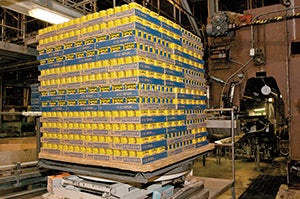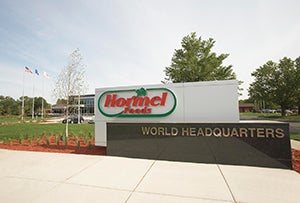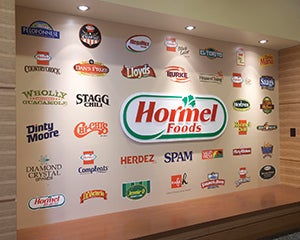Special report: Hormel surges ahead
Published 2:07 am Monday, March 11, 2013
Acquisitions, innovation push company’s profits to record levels
—This feature originally appeared in Progress 2013. Get a copy at the Austin Daily Herald office, 310 Second St. NE.
Jim Splinter went to Austin Packer cross country meets last fall like the other parents. His daughter, senior Haley Splinter, was second on the team most of the year and qualified for state meet. But unlike the other parents, the day after each meet Splinter was back at work as group vice president of Hormel’s grocery division, which tallied $1.17 billion in sales in 2012.
Splinter, who has been with Hormel Foods Corp. or a subsidiary for about 30 years, lives in Austin with his family, and says the company now netting more than $8 billion per year in sales is still focused on being a part of the Austin community and maintaining the family feel upon which it was founded in 1891.
“We want to be engaged,” said Splinter, a Vision 2020 Community Recreation Center committee member also active with the Austin YMCA.
But Hormel isn’t the company it was 100, 50, or even 10 or five years ago. When Splinter became senior vice president of sales and marketing at Jennie-O in 1999, the meatpacker had less than $4 billion in total sales. In 2012, Hormel cleared $8.2 billion in sales and $500 million in profit, both records. Over the past decade, through acquisitions of household name brands like Jennie-O Turkey Store, Farmer John, Country Crock and now Skippy, and through a heavy emphasis on product innovation, the company has positioned itself as a U.S. meat industry leader.
Recession proof?
Like much of Hormel, Splinter’s grocery division has had substantial, steady growth through the recession that started in 2008.
The grocery division has grown 38 percent in the past six years, or a $324-million increase from $846 million in sales in 2006. The segment increased 10 percent, or by $106 million, from 2011 to 2012 alone. The company as a whole went from $5.75 billion in total sales in 2006 to $8.23 billion last year, a 43.3 percent increase.
In addition, Hormel’s annual profit has increased four years running; by 20.1 percent in 2009, 15.4 percent in 2010, 19.9 percent in 2011, and 5 percent in 2012. The only dip occurred during the first year of the recession, from $301.9 million in 2007 to $285.5 million in 2008, a 5 percent drop.
“We’ve done quite well [throughout the recession],” said Hormel President and CEO Jeff Ettinger at the company’s shareholders meeting in January. “We have seen some phases where [some areas] of business were down a little bit in the early days of the recession, but overall if you look at our track record over the past four or five years, we’ve found ways to continue to grow the business.”
Ettinger talks about Hormel’s diverse portfolio, which he says allows the company to grow even when certain segments are down. So when the recession hit, Hormel relied on its cheaper meat products to pick up the slack.

Hormel Foods CEO Jeff Ettinger holds his annual press conference before the start of the annual shareholders meeting this year.
“I think especially early on we did see some benefits in the canned meat segment of the business,” he said. “During the first year or two of the recession, Spam, Dinty Moore and Hormel Chili were up double digits, and that’s probably a little bit higher growth rate than we typically see for those products.”
Since then, those products’ growth has moderated, he says, and now Hormel is battling increased grain costs because of the drought, something that’s reflected in the refrigerated division, the only one of Hormel’s five segments to report a decrease in profit — down 22 percent — in 2012 from the year before.
When the drought hit, grocery products — in particular Spam and the Don Miguel brand of MegaMex Mexican food, Hormel’s recent acquisition — made up the difference. For the year, Hormel reported a 12 percent increase in profits and a 10 percent increase in total sales for its grocery products division, which includes Don Miguel.
The company cited a strong year for Spam — as Hormel unveiled two new flavors of the canned meat and a strong marketing campaign based on its 75th birthday — and even more so for Don Miguel. Taking the Mexican brand out of the equation, the grocery division only would have had a 1 percent increase in sales over 2011.
“Last year, the grocery division had a very good year,” Splinter said. “MegaMex continues to perform very well, driving volume growth, and it has very good margins.”
And Spam helped, too.
“We don’t believe in product life cycles, or that [products like Spam] reach maturity and decline,” he said. “We think of extending them for the long term.”
Skippy and China
To Splinter and others at Hormel — a company based on meat for nearly 122 years — buying Skippy peanut butter makes perfect sense.
“It’s a very strategic move,” said Splinter, explaining that Hormel sells protein, and Skippy gives them a non-meat protein to diversify their portfolio further. And through innovation, they hope to make Skippy much more than peanut butter in a jar.
“It balances risk exposure,” Splinter said. “But it also helps us extend into untapped categories [for peanut butter]; baking, snacking, breakfast, a lot of very fun innovation opportunities.”
Hormel announced on Jan. 3, 2013, it had acquired Skippy for $700 million, and immediately started discussing ways to innovate the brand, along with using it to tap into the international and Asian, specifically Chinese, markets.
Skippy is the No. 2 peanut butter brand in the U.S. behind Jif, and the top brand in China, where Ettinger says peanut butter is a growing category. While Hormel’s international sales only accounted for 4 percent of its total sales in 2012, the division has been growing much faster than the company’s others, and Skippy’s projected $100 million in sales outside the U.S. — including $30 to $40 million in China — would be an immediate boost of 30 percent for Hormel’s total sales abroad.
“When we compare ourselves to other food manufactures within our industry, we’re really quite low in terms of our sales outside the United States,” Ettinger said. “We’ve said we’d really like to increase that. The Skippy acquisition was certainly one great opportunity to do that.”
The company expects the peanut butter category to grow domestically, too, even as some schools move toward a no peanut butter lunch policy because of some children’s severe allergies.
“In terms of allergies, I think society is figuring out best how to handle that,” Ettinger said. “But overall, the category continues to grow. It’s a great tasting, convenient, inexpensive protein, so we’re confident it will find avenues to get to multiple consumers.”
A bigger family
Ettinger says the company will continue to look for acquisitions as they come up if they’re a good fit. And through acquisitions, innovation and a balanced business model, the goal is for the company to grow at a clip of 5 percent in sales and 10 percent in earnings. So how big is too big?
“There’s no magic number,” Ettinger said. “One of the things I think about and talk about with our team is to make sure we keep the family feeling, to make sure we keep a lean organization where everyone has a lot of access to the decision makers within the company.”
Ettinger says as they’ve grown, and more than doubled sales in 12 years, they’ve preserved most of that family feel.










